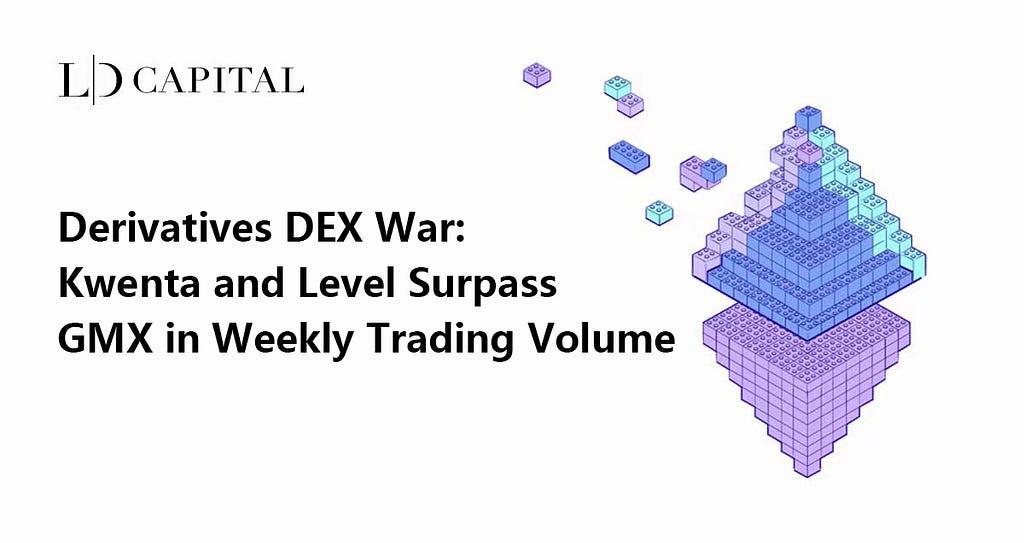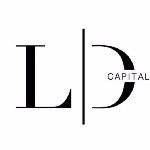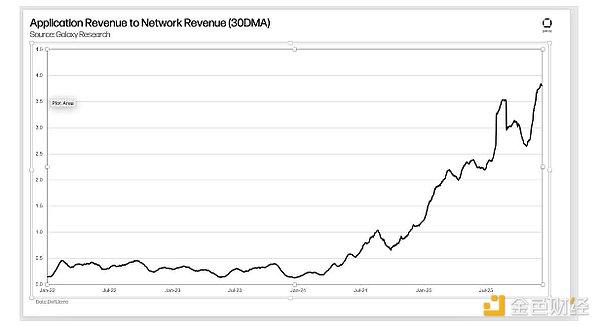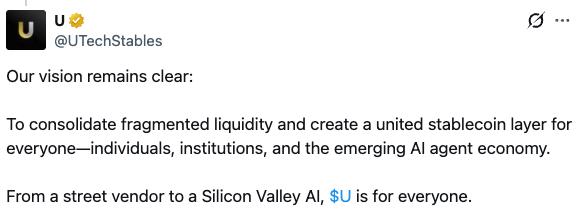
Currently, the competition is fierce in the DEX derivatives sector. Despite the overall market trading volume declining, new protocols are constantly being introduced. In a shrinking market, traders have become more sensitive to various incentive measures and yield rates, prompting DEX derivatives to compete more aggressively for users.
Since late March in 2023, the overall trading volume of DEX derivatives has been on a downward trend. Out of the six main DEX derivative protocols, five have shown a declining trend in trading volume, with only Kwenta demonstrating counter-trend growth.
Kwenta, a perpetual front-end built on Synthetix, has contributed to over 95% of the trading volume growth and revenue growth of Synthetix. Synthetix, in turn, is a liquidity provision protocol with a TVL exceeding $400 million, supplying liquidity pools to frontend projects like Kwenta.
Figure: Weekly Trading Volume of Major DEX Derivatives

*The data related to this article primarily comes from Tokenterminal. Due to varying measurement standards, there may be discrepancies between different data platforms.
Order book-based DYDX still occupies nearly half of the market’s trading volume. However, in the liquidity pool derivatives DEXs, GMX has been challenged by Kwenta and Level. Particularly in this week, Kwenta and Level’s trading volume exceeded that of GMX.
Table: Weekly trading volume of main derivatives DEX since April 2023 (in millions)

Figure: Market Share Distribution of Liquidity Pool-Based Derivatives DEX

GMX’s peak trading volume occurred in mid-April, after which it displayed a continuous downward trend. The current trading volume level is comparable to that at the end of 2022.
Figure: Weekly Changes in GMX Trading Volume

Kwenta, a DEX launched at the end of 2022, saw a substantial increase in trading volume beginning from mid-February 2023 when it initiated a trading incentive program. As of late April, they incorporated the use of OP tokens as part of their incentives, which further propelled a marked surge in trading volume throughout May.
Figure: Kwenta Trading Volume Weekly Changes

Level also experienced its peak trading volume in mid-April, reaching $2 billion in that week, followed by a decline. However, a rebound occurred in the week of May 22nd.
Figure: Weekly Changes in Level Trading Volume

Reasons for Growth in Trading Volume: More Incentives, Lower Costs
The counter-trend growth in Kwenta’s trading volume can potentially be attributed to two factors:
Firstly, Kwenta has been more aggressive in terms of trading incentives. In addition to token incentives from the protocol itself, starting from April 26, 130,000 OP tokens were rewarded each week. From May 10 to August 30, the weekly reward increased to 330,000 OP tokens, with a market value of about $500,000.
Secondly, Kwenta’s transaction fees are relatively lower than GMX. The current transaction fee ranges from 0.02% to 0.06%, varying based on whether one is a taker or maker. GMX, on the other hand, charges a transaction fee of 0.1%, along with loan fees based on positions held. For actual users, the cost of transacting on Kwenta is lower.
Figure: Kwenta Trading Incentive Rules

Level has also implemented trading incentives. For every $1 of transaction fees paid by a user, they receive one Level Loyalty token (lyLVL). Each day, a total of 10,000 LVL tokens are distributed, their allocation being determined by the proportion of an individual user’s lyLVL in comparison to the total lyLVL across the platform. Users have a 24-hour window to claim these rewards.
Beyond the basic rewards mentioned above, there’s also a Ladder reward mechanism in place. When the platform’s daily revenue exceeds a specific threshold, an extra allotment of LVL tokens is added as an incentive. These additional rewards accumulate over time and are distributed on a weekly basis.
Note:Level n = (Revenue-$100,000)/$50,000

The Ladder reward is for the top 20 traders on the weekly leaderboard. A trader’s rank is determined by the number of points they have accumulated throughout the week. Reward Points are earned based on the trader’s contribution to the protocol’s transaction fees and can be increased by multiplying by (1 + boost). The boost factor is determined by the total number of LVL tokens a trader has staked on the platform. For every 1000 LVL tokens staked, the boost factor increases by 1%.
Over the past six months, there have been 46 days when the revenue exceeded $100,000, accounting for 25% of all days. Of these, there were 19 days when the revenue exceeded $150,000, eight days when it exceeded $200,000, and two days when it exceeded $250,000.
Figure: Daily Revenue of Level

Additionally, the order book model of DYDX has maintained a high level of trading incentives since its launch. Although the incentive tokens have been reduced twice, there are still approximately 1.58 million DYDX tokens as incentives per epoch. If valued at market prices, this amounts to around $3 million, with daily incentives reaching $100,000. In the current derivatives DEX model, this is a relatively high incentive.
It’s crucial to take into account the effects of trading incentives on the selling pressure exerted on protocol tokens, along with their long-term sustainability.
In Kwenta’s incentive schemes, the ecosystem token, OP, constitutes the major portion of rewards, while the protocol token incentives are gradually decreasing. This leads to slightly reduced sell-off pressure on the protocol tokens. Furthermore, Kwenta’s trading incentives are acquired in a weekly cycle and come with a vesting period. If tokens are unlocked prematurely, a portion of them needs to be burnt. Currently, OP’s incentives are set to last until August 30. If there are no subsequent measures in place once this period lapses, it could result in a substantial decrease in trading volume.
All of Level’s incentives are based on the protocol token, which can be claimed daily without any lock-in period, resulting in increased selling pressure on the protocol token. Additionally, Level’s Ladder incentive mechanism, which aims to boost trading volume, offers substantial rewards to the top 20 users, far more than what average users receive. This could potentially lead to a significant concentration in trading volume.
DYDX also faces substantial selling pressure due to its large token incentives and the release of a large number of tokens. The market is continuously monitoring and waiting for the launch of the DYDX chain and modifications to the token mechanism.
Analysis of Real Trading Volume
Given the presence of trading incentives, it is necessary to analyze trading volumes to understand the rough situation of real trading. We have briefly compiled statistics on the number of users, trading volume, concentration, and position size for several AMM-based derivatives DEXs.
Table: Analysis of Trading Volume in AMM-Based Derivatives DEXs

GMX has 4–5 times the number of users compared to other projects and has significantly more open interest, three times that of Kwenta and five times that of the Gains Network.
In addition, the average trading volume per user for Kwenta and Level is significantly higher than for other projects without incentive measures.
For Kwenta, the average 30-day trading volume is approximately 1.6 million, four times that of GMX. The top five traders account for 33.35% of the trading volume, indicating a relatively low concentration. It has 2986 users, making it the leader in the second tier. The open interest fluctuates between 40 million and 60 million.
Level has an average 30-day trading volume of 5.76 million, a staggering 15 times that of GMX. Its trading volume is highly concentrated, with nearly 75% coming from the top five traders. The open interest is only 2.6 million, and there are less than 600 users, indicating a high proportion of wash trading on the platform.
Overall, GMX still leads the field with a significant advantage in terms of user count and open interest. Kwenta has more real users, and its trading volume is less centralized. After attracting a portion of the users with its incentive measures, it might retain users by offering better liquidity depth and lower fees. Level, on the other hand, has a relatively high proportion of wash trading and high inflation.
Recent Development Plans
GMX
Based on information obtained from the community, the GMX project team attributes the decline in trading volume and yield to an overall market downturn.
GMX’s recent focus is on the launch of its V2 version. The V2 test version was launched on May 17th, 2023, and users can participate in the testing. The main modifications include:
GLP is transitioning from a combined pool to separate pools for each currency pair. This segregation allows for the inclusion of higher-risk assets.
Two types of assets will exist: one type includes trading pairs backed by native assets like BTC and ETH, and the other comprises synthetic asset trading pairs entirely backed by USDC. Traders will have the freedom to choose the liquidity of various pools.
Indeed, with multiple pools, the task for LPs will become more complex as they need to analyze usage and yield changes of each pool to decide their participation.
The funding rate and price impact factor have been implemented to balance the changes between long and short parties.
Kwenta
On May 25th, Kain Warwick, the founder of Synthetix, proposed several ideas for the future development of Synthetix, which including:
Implementing SNX for trading incentives, with a plan to allocate 5 to 10 million SNX to the incentive program.
Considering the introduction of passive staking for SNX to enhance participation and expand the size of the liquidity pool. Previously, Synthetix utilized an active staking model, where stakers had to outperform the overall staking pool to earn higher yields or utilize hedging tools to mitigate risks. The addition of a passive staking pool simplifies the process and facilitates user participation while maintaining a baseline yield.
Subsidizing the costs of front-end operations. Currently, the income of front-end operators largely goes to SNX stakers, which may not provide sufficient incentives for them in the long-term, for instance, protocol revenues from Kwenta are entirely allocated to SNX stakers.
It is suggested to allocate a certain proportion (e.g., 10 million SNX) from the treasury to subsidize front-end costs, and representing the front-end through staking. This measure will generate a baseline fee revenue of 3–5%
Given the above, these plans consider the relationships between users, funds, and product development, and if implemented, could have significant incentivizing effects for projects constructed on the Synthetix.
Level
In May, Level conducted a community vote and introduced a new cross-chain feature by migrating to Arbitrum. Currently, liquidity pools for the LVL token have been deployed on Arbitrum, enabling trading activities. The front-end trading operations are expected to go live in mid-June. Given the substantial user base and liquidity on Arbitrum, the migration is expected to draw in a fresh influx of users and foster increased capital participation.
LD Capital is a leading crypto fund who is active in primary and secondary markets, whose sub-funds include dedicated eco fund, FoF, hedge fund and Meta Fund.
LD Capital has a professional global team with deep industrial resources, and focus on develivering superior post-investment services to enhance project value growth, and specializes in long-term value and ecosystem investment.
LD Capital has successively discovered and invested more than 300 companies in Infra/Protocol/Dapp/Privacy/Metaverse/Layer2/DeFi/DAO/GameFi fields since 2016.
website: ldcap.com
twitter: twitter.com/ld_capital
mail: BP@ldcap.com
medium:ld-capital.medium.com








